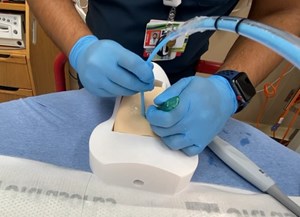
Planning your Best Clinical Ultrasound Conference
Sara Damewood, MD, FACEP @SonoSara
John Bailitz, MD, FACEP @GritCoachMd
Creagh Boulger, MD @CreaghB
Jeremy Boyd, MD, FACEP @geek_md
Hani Kuttab, MD @hanikuttab
Resa E. Lewiss, MD @ResaELewiss
Rachel Liu, MD, FACEP @RubbleEM
Yiju Teresa Liu, MD, FACEP @Tee1540
So, you’re planning your first ultrasound conference. We have been there. Whether it is for 20 or 2,000 people, we share six ways to make your ultrasound conference a standout learner-centered, inclusive, and fun experience.
1. The Content
A conference planning team creates the overarching theme, vision and goals for the conference. Ideally, this team targets content that meets and exceeds the needs of the audience. Mixing up the delivery styles of sessions breaks up the monotony of a traditional lecture style conference, and infusing gamification features adds to the fun. Avoid too many panels. Break-out sessions allow a wide variety of topics and targets different levels of expertise and specialties. Strategically organized content gives conference participants multiple opportunities to engage. Having a mechanism for feedback on content and speakers can inform how to optimize future conferences.
2. The Speakers
Stellar speakers are a must; be sure to invite well in advance. Helping prepare invited speakers to give their best talk is worth the effort. Offering speaker coaches and/or speaker resources on delivery and design can optimize speakers’ impact, as previously described. Encourage speakers to practice their talks in advance to help stay within the scheduled time frames of the agenda. Dedicating a team member to support speakers and troubleshoot audiovisual equipment can help smooth transitions, especially if a hybrid set up is desired.
3. The Budget
Having budget clarity allows the rest of the conference pieces to fall into place. Solicit sponsorship early, with defined parameters of involvement. This ranges from in-kind sponsorship like machine rentals or financial sponsorship for a social event. Venues, catering, continuing medical education credits (CME), audiovisual equipment rental, and standardized patients tend to comprise most conference budgets. Securing the venue is often the first step in setting dates and participant capacity. Understanding conference costs help determine the conference registration fee and the provision of speaker honoraria, reimbursement, swag, and entertainment options.
4. The Audience Experience
Sometimes overlooked, the participant experience can help set the right tone for your conference. What path will participants have to travel to and around the conference? Does the venue have comfortable, accessible seating, good sight lines to the projector screen, and access to power outlets? Choosing healthy options for snacks and meals, as well as access to caffeine, keeps participants energized. Be mindful of start times, body function breaks, and movement to optimize participant engagement.
5. The Communications
No one will know what a great conference you’ve planned without advertising. Promote your conference early, potentially with save the date flyers and a mechanism for participants to indicate interest early, to help with logistical planning. A multi-modal approach to communications can help reach a broader audience. Posting announcements on a social media platform (e.g., Twitter, Instagram) leading up to the conference sustains interest. Consider designing a conference website with travel information, agenda, and other resources for participants to reference.
6. Getting to Inclusivity and Belonging
The conference planning team can elevate speakers and participants, with a vision for conference diversity, equity, and inclusion. Be mindful to invite speakers from different practice environments, specialties, and geographic locations. Offer opportunities for participation at various career stages: trainees, junior and senior clinicians. If standardized ultrasound models are part of the conference, consider recruiting a diverse pool with varied ages and backgrounds. Reduce any barriers to encourage participation, such as providing an honorarium for speakers or scholarships for conference attendees who may have a financial need.
Lactation stations and childcare provision are important to send a message of accessibility and flexibility. Ask conference attendees about dietary restrictions and work with your caterers to make these accommodations. Be mindful of scheduling conferences that may conflict with holidays, including religious, school, and other. Note the dates of board examinations. Lastly, consider virtual/hybrid opportunities for those who may not be able to attend in-person, and who are interested in participating.
A Final Thought
It can be incredibly rewarding to host a conference. There are many details to consider. In summary, start early and assemble a team. Keep inclusivity central to your plan. Reflect on the many conferences you have attended in the past: What worked well? Which were the most successful and why? Above are just a few of many strategies to include in your preparation toolkit for your next best clinical ultrasound conference.



